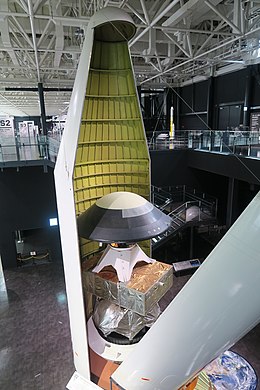
Back OREX Catalan OREX Spanish OREX French Orbital Reentry Experiment Galician りゅうせい Japanese Ryusei (satelita) Polish
 1:1 scale model of OREX and the Vehicle Evaluation Payload within the H-II fairing, at the Kakamigahara Air and Space Museum | |
| Mission type | Technology |
|---|---|
| Operator | NASDA |
| COSPAR ID | 1994-007A |
| SATCAT no. | 22978 |
| Website | www |
| Mission duration | 2 hours |
| Spacecraft properties | |
| Manufacturer | NASDA |
| Launch mass | 865 kilograms (1,907 lb) |
| Landing mass | 761 kilograms (1,678 lb) |
| Start of mission | |
| Launch date | 3 February 1994, 22:20 UTC[1] |
| Rocket | H-II |
| Launch site | Tanegashima Yoshinobu 1 |
| End of mission | |
| Landing date | 4 February 1994, 00:30 UTC[2] |
| Landing site | Pacific Ocean |
| Orbital parameters | |
| Reference system | Geocentric |
| Regime | Low Earth |
| Perigee altitude | 448 kilometres (278 mi) |
| Apogee altitude | 458 kilometres (285 mi) |
| Inclination | 30.5 degrees |
| Period | 93.64 minutes |
| Epoch | 3 February 1994[3] |
OREX (Orbital Re-entry Experiment) was a NASDA re-entry demonstrator prototype which was launched in 1994 on the H-II launcher; the satellite was renamed Ryūsei (りゅうせい, Shooting star). It was a precursor for the Japanese space shuttle HOPE.
OREX tested various communications systems, heating profiles and heat shielding components for HOPE.
- ^ McDowell, Jonathan. "Launch Log". Jonathan's Space Page. Retrieved 9 November 2013.
- ^ McDowell, Jonathan (7 February 1994). "Issue 183". Jonathan's Space Report. Retrieved 9 November 2013.
- ^ McDowell, Jonathan. "Satellite Catalog". Jonathan's Space Page. Retrieved 9 November 2013.